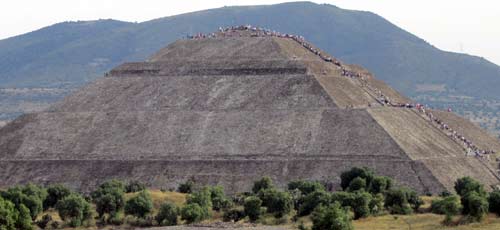GuanajuatoMexicoCity.com
The best independent guide to Mexico City
GuanajuatoMexicoCity.com
The best independent guide to Mexico City
Pyramid of the Sun Teotihuacan
The Pyramid of the Sun is the third largest pyramid in the world and the entire Teotihuacan temple complex is one of the best tourist attractions in Mexico City. The Pyramid of the Sun is commonly believed by most tourists to be an Aztec temple, but this is not true as it was constructed by the much earlier civilization: the Teotihuacans.

The Aztecs, during their domination of Mexico, thought that only their gods could have constructed such a structure and used it as their primary temple for daily rituals and sacred sacrifices. For visitors, the Pyramid of the Sun is an outstanding monument. Its sheer size and height are a wonder, with only the fittest tourists able to complete the steep climb to the summit.
Interesting Facts about the Pyramid of the Sun
At the zenith of the Teotihuacan civilization in 450 AD, when the city had an estimated population of 150,000, the Sun Temple would have been covered with vivid murals and images of their gods. Its lime based plaster has eroded over the centuries, so all that’s seen today is the drab grey block of the inner structure.

A tourist snaking climbing the Pyramid of the Sun in Teotihuacan
The Pyramid of the Sun at Teotihuacan is classified as the world’s third largest pyramid coming third to the two Egyptian pyramids of Giza. The low incline and squat structure of the Sun Temple means that the perimeter at the base of the Sun Pyramid is almost the same as the Great Pyramid of Egypt. The walk around the base takes a whole 15 minutes and covers 894 meters, while the Giza Pyramid has a perimeter of 920m. The main attraction of the Sun Temple is that visitors can climb the 248 steps to the top of the 75-meter pyramid. From the summit there are wonderful views over the Avenue of the Dead, which leads to the younger Pyramid of the Moon.
It is well documented that the Aztecs used the pyramid as a site for animal and human sacrifices to their gods, but surprisingly little is known about the reasoning behind the construction by the Teotihuacans and the use of the pyramid. Inside the pyramid is a hidden 300 m long corridor that leads to a central chamber that at one point had a natural spring. This source of water may indicate the reason for exact positioning of the pyramid. Remains of charcoal have been identified inside, indicating ceremonies involving water and fire, but the present theory involves the structure being a royal tomb.
The Pyramid of the Sun at Teotihuacan was constructed in four discreet sections, with each layer providing a substantial base for the following section. This design explains the gentle 30-degree slope of the pyramid walls as each hold in vast volumes of soil, rubble and rocks. The building techniques employed were simplistic, but the sheer size of the pyramid makes the structure phenomenal.
Pyramid of the Sun Teotihuacan Tourist Guide
The Teotihuacan temple complex is open every day from 8:00 am until 5:00 pm. The Teotihuacan complex is possibly the only Mexican museum or national monument that is open on a Monday. The relatively early closing time and final bus back to Mexico City often catches out visitors. Always aim to get to the pyramids as early in the day as possible.
For a guide about traveling to Teotihuacan from Mexico City, please click here. The entrance fee is $57.00 pesos with an additional fee of $45.00 pesos for video cameras. Teotihuacan is at a lower elevation than Mexico City and this combined with the lower pollution levels means that it’s always much hotter at Teotihuacan than Mexico City. Always take a hat and have plenty of water, as there is little shade.



















